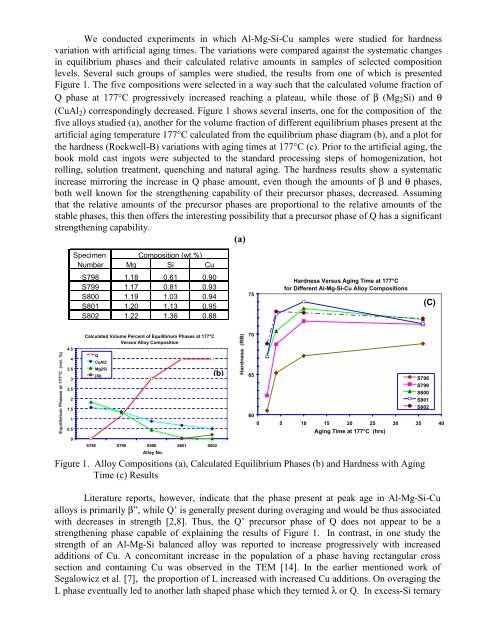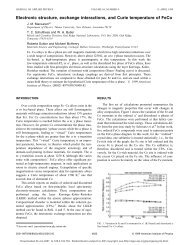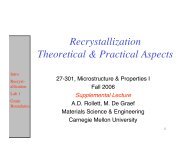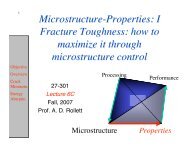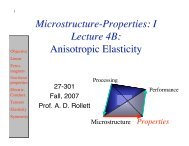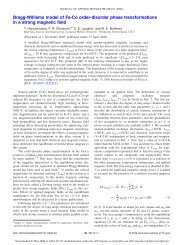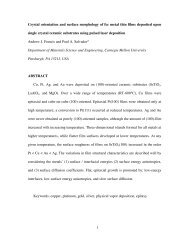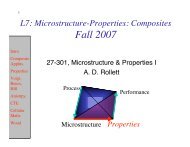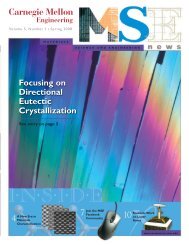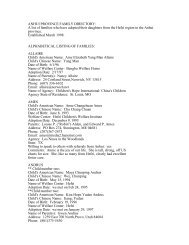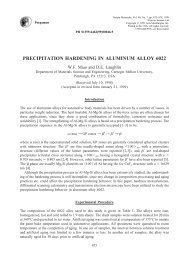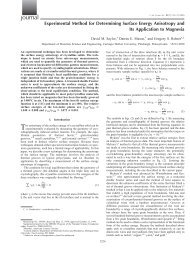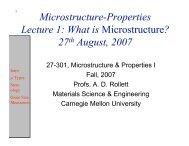Precipitation In Al-Mg-Si Alloys with Cu - Materials Science and ...
Precipitation In Al-Mg-Si Alloys with Cu - Materials Science and ...
Precipitation In Al-Mg-Si Alloys with Cu - Materials Science and ...
Create successful ePaper yourself
Turn your PDF publications into a flip-book with our unique Google optimized e-Paper software.
We conducted experiments in which <strong>Al</strong>-<strong>Mg</strong>-<strong>Si</strong>-<strong>Cu</strong> samples were studied for hardness<br />
variation <strong>with</strong> artificial aging times. The variations were compared against the systematic changes<br />
in equilibrium phases <strong>and</strong> their calculated relative amounts in samples of selected composition<br />
levels. Several such groups of samples were studied, the results from one of which is presented<br />
Figure 1. The five compositions were selected in a way such that the calculated volume fraction of<br />
Q phase at 177°C progressively increased reaching a plateau, while those of β (<strong>Mg</strong>2<strong>Si</strong>) <strong>and</strong> θ<br />
(<strong>Cu</strong><strong>Al</strong>2) correspondingly decreased. Figure 1 shows several inserts, one for the composition of the<br />
five alloys studied (a), another for the volume fraction of different equilibrium phases present at the<br />
artificial aging temperature 177°C calculated from the equilibrium phase diagram (b), <strong>and</strong> a plot for<br />
the hardness (Rockwell-B) variations <strong>with</strong> aging times at 177°C (c). Prior to the artificial aging, the<br />
book mold cast ingots were subjected to the st<strong>and</strong>ard processing steps of homogenization, hot<br />
rolling, solution treatment, quenching <strong>and</strong> natural aging. The hardness results show a systematic<br />
increase mirroring the increase in Q phase amount, even though the amounts of β <strong>and</strong> θ phases,<br />
both well known for the strengthening capability of their precursor phases, decreased. Assuming<br />
that the relative amounts of the precursor phases are proportional to the relative amounts of the<br />
stable phases, this then offers the interesting possibility that a precursor phase of Q has a significant<br />
strengthening capability.<br />
(a)<br />
4.5<br />
Specimen Composition (wt.%)<br />
Number <strong>Mg</strong> <strong>Si</strong> <strong>Cu</strong><br />
S798 1.18 0.61 0.90<br />
S799 1.17 0.81 0.93<br />
S800 1.19 1.03 0.94<br />
S801 1.20 1.13 0.95<br />
S802 1.22 1.36 0.88<br />
4<br />
3.5<br />
3<br />
2.5<br />
2<br />
1.5<br />
1<br />
0.5<br />
0<br />
Calculated Volume Percent of Equilibrium Phases at 177°C<br />
Versus <strong>Al</strong>loy Composition<br />
Q<br />
<strong>Cu</strong><strong>Al</strong>2<br />
<strong>Mg</strong>2<strong>Si</strong><br />
(<strong>Si</strong>)<br />
S798 S799 S800 S801 S802<br />
<strong>Al</strong>loy No.<br />
(b)<br />
Hardness Versus Aging Time at 177°C<br />
for Different <strong>Al</strong>-<strong>Mg</strong>-<strong>Si</strong>-<strong>Cu</strong> <strong>Al</strong>loy Compositions<br />
Figure 1. <strong>Al</strong>loy Compositions (a), Calculated Equilibrium Phases (b) <strong>and</strong> Hardness <strong>with</strong> Aging<br />
Time (c) Results<br />
Literature reports, however, indicate that the phase present at peak age in <strong>Al</strong>-<strong>Mg</strong>-<strong>Si</strong>-<strong>Cu</strong><br />
alloys is primarily β”, while Q’ is generally present during overaging <strong>and</strong> would be thus associated<br />
<strong>with</strong> decreases in strength [2,8]. Thus, the Q’ precursor phase of Q does not appear to be a<br />
strengthening phase capable of explaining the results of Figure 1. <strong>In</strong> contrast, in one study the<br />
strength of an <strong>Al</strong>-<strong>Mg</strong>-<strong>Si</strong> balanced alloy was reported to increase progressively <strong>with</strong> increased<br />
additions of <strong>Cu</strong>. A concomitant increase in the population of a phase having rectangular cross<br />
section <strong>and</strong> containing <strong>Cu</strong> was observed in the TEM [14]. <strong>In</strong> the earlier mentioned work of<br />
Segalowicz et al. [7], the proportion of L increased <strong>with</strong> increased <strong>Cu</strong> additions. On overaging the<br />
L phase eventually led to another lath shaped phase which they termed λ or Q. <strong>In</strong> excess-<strong>Si</strong> ternary<br />
75<br />
70<br />
65<br />
60<br />
(C)<br />
S798<br />
S799<br />
S800<br />
S801<br />
S802<br />
0 5 10 15 20 25 30 35 40<br />
Aging Time at 177°C (hrs)


